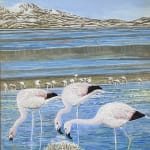Carol Ogilvie
Set of Six Originals for the book: Flamingos
Watercolour heightened with bodycolour
Size without frame 16 3/4 x 12 ins
Size with frame 22 3/4 x 18 ins
Size with frame 22 3/4 x 18 ins
Further images
-
(View a larger image of thumbnail 1
)

-
(View a larger image of thumbnail 2
)

-
(View a larger image of thumbnail 3
)

-
(View a larger image of thumbnail 4
)

-
(View a larger image of thumbnail 5
)

-
(View a larger image of thumbnail 6
)

-
(View a larger image of thumbnail 7
)

-
(View a larger image of thumbnail 8
)

-
(View a larger image of thumbnail 9
)

-
(View a larger image of thumbnail 10
)

-
(View a larger image of thumbnail 11
)

-
(View a larger image of thumbnail 12
)

Carol Ogilvie is a freelance artist painting mainly birds and other wildlife subjects and has illustrated 'Ducks of Britain and Europe', 'Wild Geese' and 'Bird Watching on Inland Freshwaters'. She is married to Malcolm Ogilvie, one time Senior Research Officer at the Wildfowl Trust, Slimbridge, ornithologist and wildlife author of numerous publications; they now reside on Islay where both husband and wife are intimately involved with wildlife matters.
This set of six watercolours are the original colour illustrations for their book 'Flamingos', published in 1986. I quote from the publisher's blurb: "Flamingos are a great attraction at all the world's major zoos and bird gardens. They also provide one of the most magnificent of wildlife spectacles when gathered in flocks of tens or hundreds of thousands. Their strange shape and postures and their wonderful pink and red colouring have aroused interest since Roman times.
Malcolm and Carol Ogilvie's book is the only work in print [1986] dealing comprehensively with this group of highly attractive birds and gives all the known facts about the world's six different kinds of Flamingo. In South America are the Chilean; the James's, whose breeding grounds were only discovered in 1957; and the rare Andean, numbering less than 50,000. In Mexico, and the Bahamas live the rosy-red Caribbean, while its Old World counterpart is the Greater Flamingo, breeding in southern Europe, Africa and India. The Lesser Flamingo is numbered in millions, yet the secrets of its breeding haunts in East Africa were only revealed 30 years ago.
Flamingos nest in large colonies, many thousands together, but are fickle breeders, dependent on erratic rainfall for just the right breeding conditions. The details of their breeding cycle are here, given together with descriptions of their many dramatic displays. There are many threats to Flamingos in different parts of the world, though successful management has saved some colonies. Greater protection is needed in several areas, and much is still to be learnt about keeping Flamingos in captivity."
Andean Flamingo (Phoenicoparrus andinus) Plate 6 of Flamingos 1986
James's Flamingo (South America) Plate 7 of Flamingos 1986
Chilean Flamingo (Phoenicopterus chilensis) Plate 5 of Flamingos 1986
Lesser Flamingo (Phoeniconaiae minor) Plate 3 of Flamingos 1986
Greater Flamingo (Phoenicopterus ruber roseus) Plate 2 of Flamingos 1986
Caribbean (or Rosy) Flamingo Plate 1 of Flamingos 1986
The set of six framed original watercolours is £1,800, book included.
This set of six watercolours are the original colour illustrations for their book 'Flamingos', published in 1986. I quote from the publisher's blurb: "Flamingos are a great attraction at all the world's major zoos and bird gardens. They also provide one of the most magnificent of wildlife spectacles when gathered in flocks of tens or hundreds of thousands. Their strange shape and postures and their wonderful pink and red colouring have aroused interest since Roman times.
Malcolm and Carol Ogilvie's book is the only work in print [1986] dealing comprehensively with this group of highly attractive birds and gives all the known facts about the world's six different kinds of Flamingo. In South America are the Chilean; the James's, whose breeding grounds were only discovered in 1957; and the rare Andean, numbering less than 50,000. In Mexico, and the Bahamas live the rosy-red Caribbean, while its Old World counterpart is the Greater Flamingo, breeding in southern Europe, Africa and India. The Lesser Flamingo is numbered in millions, yet the secrets of its breeding haunts in East Africa were only revealed 30 years ago.
Flamingos nest in large colonies, many thousands together, but are fickle breeders, dependent on erratic rainfall for just the right breeding conditions. The details of their breeding cycle are here, given together with descriptions of their many dramatic displays. There are many threats to Flamingos in different parts of the world, though successful management has saved some colonies. Greater protection is needed in several areas, and much is still to be learnt about keeping Flamingos in captivity."
Andean Flamingo (Phoenicoparrus andinus) Plate 6 of Flamingos 1986
James's Flamingo (South America) Plate 7 of Flamingos 1986
Chilean Flamingo (Phoenicopterus chilensis) Plate 5 of Flamingos 1986
Lesser Flamingo (Phoeniconaiae minor) Plate 3 of Flamingos 1986
Greater Flamingo (Phoenicopterus ruber roseus) Plate 2 of Flamingos 1986
Caribbean (or Rosy) Flamingo Plate 1 of Flamingos 1986
The set of six framed original watercolours is £1,800, book included.
Join our mailing list
McEwan Gallery Newsletter
* denotes required fields
We will process the personal data you have supplied in accordance with our privacy policy (available on request). You can unsubscribe or change your preferences at any time by clicking the link in our emails.
















